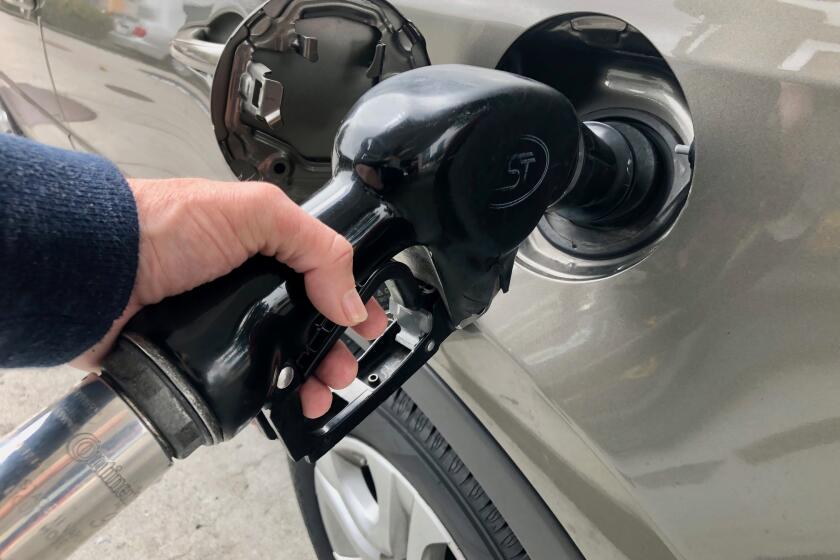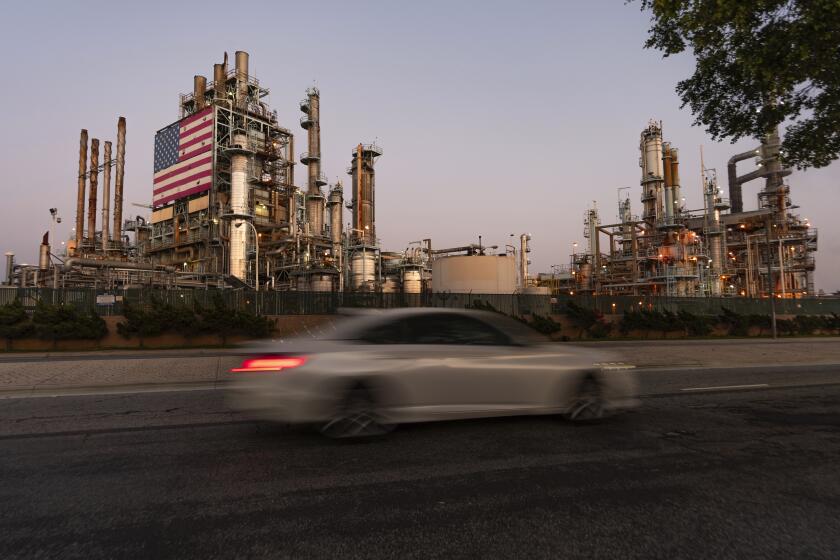Column: The Newsom administration’s confounding actions on gas prices

- Share via
SACRAMENTO — The Newsom administration is in conflict with itself on gasoline pricing, speaking from both sides of its mouth.
Is it trying to hold down prices at the gas pump or is it OK with hiking them? Both, it seems. And it smacks of hypocrisy.
One hand may not know — or care — what the other hand is doing.
On one hand, the California Air Resources Board is quietly on the verge of adopting a regulation that could make pump prices soar by nearly a half-dollar a gallon — or even much more — as detailed in a Times story by reporter Russ Mitchell.
On the other hand, both legislative houses have just passed a bill eagerly sought by Gov. Gavin Newsom that he contends will avoid “big oil’s price spikes” by allowing the California Energy Commission to require that refineries hold back an emergency supply of fuel.
When there’s a sudden supply shortage, prices spike — by 40 to 75 cents per gallon, state Sen. Nancy Skinner (D-Berkeley) told her colleagues Friday while shepherding the governor’s bill during a brief Senate debate. It’s about the old law of supply and demand.
The measure, Assembly Bill 1, passed on a 23-9 party-line vote, gaining just two votes more than needed. Several Democrats didn’t vote at all. The bill was returned to the Assembly for routine concurrence in Senate amendments, ending a special legislative session called by Newsom.
“Price spikes cost consumers more than $2 billion last year and we’re taking the action necessary to help put this to an end,” Newsom declared after the Senate vote.
As Gov. Gavin Newsom urges new controls on state oil refineries, California air regulators are considering new rules that could increase gas prices.
“This bill is just a smokescreen for what’s really coming,” asserted Catherine Reheis-Boyd, who heads the
Western States Petroleum Assn. “After November’s election, the California Air Resources Board will take action to raise gas prices even higher.”
The governor appoints all five members of the energy commission and 12 of the 16 California Air Resources Board members. The governor selects the chairs of both regulatory panels.
So, you’d think Newsom would have some influence over his appointees. Why would he push legislation to allow one entity to keep the lid on price spikes while standing by as another sends prices flying?
Sure, they’re quasi-independent agencies that are supposed to act nonpolitically. But they’re creations of politics. Governors — including Newsom — have fired plenty of chairs they felt weren’t carrying out their agendas.
And dramatically hiking gas prices is definitely not one of Newsom’s stated agendas. He’s trying to lower consumer costs.
The air board, however, does work on one Newsom priority: to lower planet-warming emissions. And it intends to vote right after the election on a plan to impose stricter limits on the carbon intensity of fuels.
That could cost motorists plenty.
A year ago, the air board estimated that the new regulation could raise gas prices by 47 cents a gallon because of refinery costs passed on to consumers. A separate study placed the pump cost much higher — 65 cents a gallon.
Now the air board has backed off its 47-cent price hike estimate. And it refuses to offer a revised forecast.
Assembly Democrats continued a pattern in California of allowing regulators to adopt more rules for the oil industry that could lower price spikes in the future.
“What we are not equipped to do is analyze what the effect [of the lower carbon standard] would be on retail gasoline prices,” CARB chief Steven Cliff told The Times’ Mitchell.
So, an unelected bunch of regulators can arbitrarily adopt new rules without weighing the cost to consumers? Doesn’t seem right. Seems a bit irresponsible and arrogant.
The Legislature perhaps should crimp the air board’s power.
One good feature of Newsom’s gas spike bill is that it does require the energy commission to conclude that the benefits outweigh the consumer costs before ordering refineries to stockpile fuel.
But whether it will do much to reduce price spikes when, for example, refineries shut down to perform maintenance, was hotly debated.
Oil lobbyists and Republicans argued that if gasoline is held off the market and placed in reserve, it will reduce supply at the pump and raise prices. That makes sense.
An energy commission spokesperson said analysts will grapple with that question when determining how much, if any, fuel should be banked.
The oil industry has been a Newsom punching bag for the last two years. “There’s a new sheriff in town,” the governor claimed last year, referring to himself. “We brought Big Oil to their knees.”
He was bragging about enactment of legislation creating a new petroleum watchdog within the energy commission. It was authorized to dig into oil industry books and pave the way for the commission to potentially establish a cap on profits and punish refineries that exceeded it.
But nothing has come of the ballyhooed cap or penalties. Newsom tends to overpromise and underdeliver.
“This bill will help a little, but overall not do a lot to save consumers on the price of gasoline,” said Severin Borenstein, faculty director at the UC Berkeley Energy Institute and an expert on gasoline production.
“It’s not a silver bullet,” Assemblyman Gregg Hart (D-Santa Barbara), the bill’s author, told me. “It’s very targeted to just spikes. It’s innovative and ambitious and pretty practical.”
Republican Sen. Brian Dahle of rural Bieber asserted at a committee hearing last week that “the biggest [gasoline] price gouger in this state is the state.” He noted that California has the nation’s highest gas tax. State, local and federal taxes combined total $1.42 per gallon, Dahle said.
Newsom should make sure that his air board appointees don’t gouge motorists even more.
But his refinery reserve seems worth trying. It’s always good to save.
More to Read
Sign up for Essential California
The most important California stories and recommendations in your inbox every morning.
You may occasionally receive promotional content from the Los Angeles Times.













